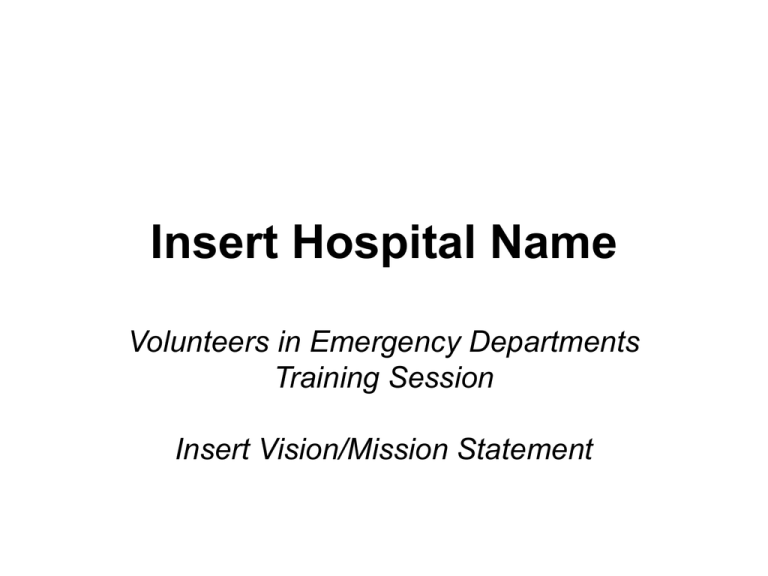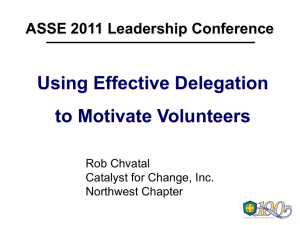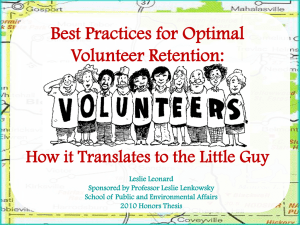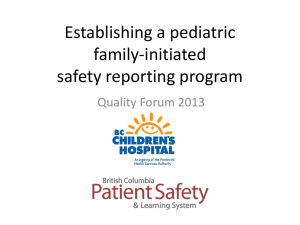Training session presentation
advertisement

Insert Hospital Name Volunteers in Emergency Departments Training Session Insert Vision/Mission Statement Welcome & Introductions <Insert name> Volunteer Coordinator <Insert name> Nurse Unit Manager <Insert name> Associate Nurse Unit Mgr <Insert name> Human Resource Dept. Training Topics covered, but not limited to:- Brief overview of the Hospital Aim and Objectives of the VED program Roles and Responsibilities of Hospital, Staff and Volunteers Recruitment and Selection Privacy and Confidentiality Uniform and Equipment Occupational Health and Safety Rostering and Shifts Feedback and Review Process Performance Management Support and Debriefing Professional Development Reimbursement and Gifts Recognition Resignation and Termination Aims & Objectives Offer practical and emotional support to patients and their carers in the ED of the Hospital Complement the role of the Hospital staff by assisting to ease emotional distress and anxiety experienced by patients and/or their loved ones Allow staff to focus on providing the clinical care that is needed Desired Outcomes Emotional distress and anxiety experienced by patients and/or their loved ones is eased Hospital staff are able to better focus on providing clinical care, thus improving outcomes for patients Patient and carer experiences in Victorian EDs are enhanced Volunteering provides a vehicle for local members of the community to assist in addressing human and social needs Build community capacity and develop social capital! Roles & Responsibilities Hospital Provide a Duty of Care to Staff, Volunteers and ED Visitors Principles of Equity govern all volunteering and employment decisions, including: recruitment, selection, training and development, conditions of service, reward and recognition • Volunteers are subject to policies and procedures applicable to all hospital staff • Any breach of conduct will result in the hospital instigating performance management measures, or for more serious matters, suspension or termination of a volunteer Roles & Responsibilities Hospital (cont) Staff and Volunteers follow procedure related to grievances Privacy and Confidentiality is maintained throughout Volunteers have access to a secure space, such as a locker, to store their personal belongings whilst performing their duties Volunteers have access to facilities such as staff rooms and toilets Roles & Responsibilities Volunteer Coordinator Recruitment and Selection of volunteers meets both program criteria and Hospital requirements Volunteers are aware of their responsibilities in relation to the program, and Hospital policies and procedures Regular consultation with Volunteers, the Volunteer Liaison Officer and the NUM Roles & Responsibilities Volunteer Coordinator (cont) Successful implementation of program monitoring and evaluation tools Nurse Unit Manager is briefed on the status of the program at least monthly Ongoing training (professional development) is available to volunteers to update their knowledge and skills relevant to their role Roles & Responsibilities Volunteer Liaison Officer Volunteers work within VED program and Hospital policies and procedures Liaise with the Volunteer Coordinator, staff, volunteers and patients, regarding the operation of the program, and report any issues or concerns Assist in the recruitment, selection and training of volunteers Roles & Responsibilities Volunteer Liaison Officer (cont) Assist in the supervision, coordination and rostering of volunteers Advise the Volunteer Coordinator of changes to volunteers’ contact details or other information Monitor volunteer participation (by checking the Communications Book) Assist in volunteer recognition Assist in the preparation of monthly reports Roles & Responsibilities Small Group Activity Form groups of 5-6 people List as many tasks as you can think of that you will be able to undertake in your role as an ED Volunteer! List as many tasks as you can think of that you will not be able to undertake in your role as an ED Volunteer! Roles & Responsibilities Volunteer Guide and orientate visitors to, and within, the ED Provide patients with practical and emotional support during their waiting period, and if requested, during treatment Liaise with patients and staff as requested to communicate non-clinical information Provide refreshments to family and friends of patients, and to those patients permitted to eat and drink Roles & Responsibilities Volunteer (cont) Offer comfort to family and friends of patients Provide diversions to occupy patients and/or their family and friends in the waiting room (magazines, books, pencils) Assist with caring for children, to allow parents/ patients to concentrate on receiving attention Work cooperatively with ED staff to ensure the non-clinical and emotional needs of patients and attending family/carers are met Roles & Responsibilities Individual Activity What are your own values? Will they affect your ability to approach and converse with patients and their family and friends of a different cultural background? Please complete the ‘Working with Difference Survey’ and retain for your own personal use Recruitment and Selection To Date Complete a Volunteer Application Form and sign the Position Description Participate in an interview Consent to, and complete the paperwork associated with, a Police Record Check and Working with Children Check Still to come Successful completion of Training! Privacy and Confidentiality Volunteers may have access to private or confidential information, at a patient, staff and organisational level Information is only to be disclosed following authorisation by either the NUM or ANUM Any breach of confidentiality will result in the Hospital instigating performance management measures, or for more serious matters, suspension or termination of a volunteer Privacy and Confidentiality Small Group Activity Form groups of 5-6 people List as many issues as you can that you might need to keep confidential Are there any circumstances where you might feel the obligation to breach patient or staff confidentiality, and if so, how would you go about doing that? Uniform and Equipment Uniform Must wear a prescribed uniform Wear comfortable shoes with closed in toes Open toe footwear, such as thongs or sandals, is not permitted whilst performing your duties as an ED volunteer Ordered upon successful completion of training Uniform and Equipment Equipment Security Identification Badge Wear at all times whilst performing duties Wear at chest level Not to be passed onto another volunteer or community member Access Card Emergency Codes Card Secure space, such as a locker, will be provided to store personal belongings Mobile Phones Access to Information Systems is prohibited, unless permission is given by the NUM or ANUM Occupational Health and Safety All staff, volunteers, patients and visitors have the right to be provided with a safe work environment! Occupational Health and Safety Volunteers have the right to a workplace free of: Discrimination (both indirect and direct) Sexual Harassment Harassment Bullying Victimisation Occupational Health and Safety Infection Control Hand Washing Food Handling Food Consumption Liquid Consumption Illness Occupational Exposures Car Parking Emergency Procedures Occupational Health and Safety Infection Control Hand Washing “Should take a minimum of 15 seconds using generous amounts of an alcohol based liquid or soap and water or gel to lather and rub each part” Before: commencing work, entering cubicles, handling food After: consuming food, visiting the toilet, using a handkerchief or tissue, touching any part of the body, smoking and wearing gloves Occupational Health and Safety Infection Control (cont) Food Handling Ensure correct hand washing technique is used prior to, and after, handling food Re-heating of food or heating of baby bottles is prohibited Food Consumption Allowed in designed areas such as the cafeteria, kiosk or staff room Occupational Health and Safety Liquid Consumption Allowed in designed areas such as the cafeteria, kiosk or staff room Volunteers are not permitted to provide patients with refreshments, without first getting permission from the clinician caring for them Volunteers are permitted to provide family and friends of patients with refreshments Occupational Health and Safety Illness The Hospital has a Duty of Care to staff, volunteers and ED visitors to provide a safe work environment, by ensuring infection risk and spread of disease is minimised Volunteers are not to attend their designated shift if ill, and should advise the Volunteer Coordinator as soon as possible Occupational Health and Safety Occupational Exposures Volunteers may experience exposure to infection risk through contact with bodily fluids and needles, resulting in the splashing, or breaking, of the epidermal layer Volunteers are not to pick up, or dispose of, needles, sick bags, soiled tissues and nappies Volunteers approached by an ED visitor appearing to be under the influence of alcohol or drugs are to inform the ANUM/Nurse-in-Charge immediately Volunteers are not to provide any clinical assistance to patients and/or their family and friends Occupational Health and Safety Car Parking Volunteers may be provided with access to the staff car park Volunteers have the right to request Hospital security to escort them to their vehicle, regardless of their finishing time, or where the vehicle is located Volunteers should understand that, requesting an security escort to their vehicle could result in a short time delay at the conclusion of their shift Occupational Health and Safety Emergency Procedures Location of protective and safety equipment The following protective and safety equipment can be found throughout the waiting room (including the triage station) and cubicles: Protective Eyewear Fire Alarms Fire Blankets Fire Extinguishers Occupational Health and Safety Emergency Procedures (cont) Correct Identification of Fire Extinguishers Occupational Health and Safety Emergency Procedures (cont) Identifying (and meaning behind) internal “Codes” Code Red: Fire/Smoke Code Blue: Medical Emergency Team Code Yellow: Internal Emergency Code Brown: External Emergency Code Grey: Unarmed Confrontation Code Black: Armed Confrontation Code Purple: Bomb Threat Code Orange: Evacuation Occupational Health and Safety Emergency Procedures (cont) In the event of an emergency Volunteers are supplied with the local emergency telephone number Volunteers are to advise the Nurse-in-Charge, or closest staff member, of an impending, or occurring emergency Volunteers are not expected to implement internal emergency procedures Volunteers exposed directly or indirectly to an emergency will be debriefed, and provided with counselling if required Rostering and Shifts Rostering Volunteers are rostered according to their availability and ED requirements Volunteers are required to commit to a minimum of two shifts per month, with the possibility of being available weekly during various stages of the year Rostering and Shifts Rostering (cont) In the event that a volunteer cannot attend a rostered shift, due to illness or other personal circumstances, they are required to: advise the Volunteer Coordinator/ Volunteer Liaison Officer as soon as possible (depending on internal processes, the volunteer may be responsible for finding a replacement) Rostering and Shifts Rostering (cont) Roster will generally be finalised a minimum of one week prior to the next month, and distributed to volunteers by either: Fax Mail Email Volunteers planning on taking an extended period of leave should advise the Volunteer Coordinator/ Volunteer Liaison Officer as soon as possible Rostering and Shifts Shifts Introduction Activity Describe what you think a typical shift will involve? What will you do if the waiting room/cubicles of the ED is relatively quiet? Rostering and Shifts Shifts (cont) The activity level of the ED is classified as either low, medium or high volume, based on the approximate number of annual ED attendances. Activity Level: Low, Medium or High Volume Rostering and Shifts Shifts (cont) Low Volume ED Monday to Friday 12 pm - 3 pm 3 pm - 6 pm Saturday to Sunday 12 pm - 3 pm 3 pm - 6 pm 6 pm - 9 pm Rostering and Shifts Shifts (cont) Medium Volume ED Monday to Sunday 12 pm - 3 pm 3 pm - 6 pm 6 pm - 9 pm Rostering and Shifts Shifts (cont) High Volume ED Monday to Sunday 12 pm - 3 pm 3 pm - 6 pm 6 pm - 9 pm 9 pm – 12 am Rostering and Shifts Shifts (cont) Communications Book: Volunteer Coordinator/Volunteer Liaison Officer and volunteers can record information relating to: any concerns or issues that arose during the course of a shift availability/unavailability of volunteers policy or procedural matters any upcoming events Rostering and Shifts Shifts (cont) Log Book: Volunteers are to use the Log Book to: sign in prior to commencing their shift sign out upon finishing their shift record the number of visitors supported during their shift Rostering and Shifts Shifts (cont) Upon commencing a shift volunteers are to: sign in the Log Book check the Communications Book for any correspondence from the previous shift or Volunteer Coordinator/Volunteer Liaison introduce themselves to the ANUM/NIC Rostering and Shifts Shifts (cont) Small Group Activity Form groups of 5-6 people How will you initiate a conversation with a visitor to the Emergency Department? Will that change if the visitor is displaying signs of pain and/or distress? What techniques/phrases could you use to deflect a potential controversial conversation topic? Rostering and Shifts Shifts (cont) At the completion of their shift, volunteers are to: detail any relevant information in the Communications Book handover to the next volunteer commencing a shift sign out in the Log Book advise the ANUM/Nurse-in-Charge that they are leaving Rostering and Shifts Shifts (cont) Breaks Volunteers are encouraged to take a 10 minute break during the course of their shift If the waiting room (and/or cubicles) is quiet, volunteers are to use their discretion in taking additional break/s Volunteers have access to, and use of, all condiments and facilities provided in the staff room Meals, or meal vouchers, will only be provided at the discretion of the ANUM/Nurse-in-Charge Feedback and Review Process Catch up after 1 month Probationary Period meeting after 3 months Quarterly Catch up meetings Volunteers are encouraged to provide feedback to the Volunteer Coordinator/Volunteer Liaison Officer Volunteers who resign, retire, or are terminated, are asked to complete an Exit Feedback Form Performance Management All matters relating to volunteer performance will aim to be resolved in the most informal and positive manner possible, such as through: Counselling Additional training and/or supervision Reassignment Verbal warnings Performance Management The following outlines the process for managing volunteer performance and behaviour: Step 1 – Notification Step 2 – Counselling Step 3 – Verbal Warning Step 4 – Written Warning Step 5 – Dismissal Performance Management In certain circumstances of serious or gross misconduct, the Volunteer Coordinator may decide to: immediately stand down a volunteer pending an investigation issue a first and final written warning Only the Executive Director or CEO, acting on the advice of the HR Dept. or Volunteer Coordinator, may dismiss a volunteer Support and Debriefing Volunteers may be exposed to unpleasant or stressful situations which have the potential to affect their emotional, mental or physical health In such cases, volunteers are encouraged to debrief with the ANUM/Nurse-in-Charge as soon as possible If either party deems the initial debrief is not sufficient, the matter will be referred to the Volunteer Coordinator, who will organise formal debriefing All discussions will remain private and confidential Quarterly Catch up meetings can be used to discuss “general” issues Professional Development Volunteer Coordinator responsibilities Assessing and identifying learning and development needs of volunteers Learning and development opportunities may incorporate, but are not limited to: Occupational Health and Safety Emergency Procedure Updates Mental Health Dementia Diabetes Substance Abuse Cultural and Linguistic Studies Ensure volunteers actively participate in identifying learning and development needs! Professional Development Volunteer responsibilities Actively participate in identifying learning and development needs Actively participate in any agreed learning and development activity Complete an evaluation form on completion of any learning and development activity Share learning experiences with other volunteers Be fairly reasonable regarding expectations of learning and development opportunities! Reimbursement and Gifts Volunteers may be eligible for reimbursement of reasonable, pre-approved, out of pocket expenses, incurred on behalf of the Hospital Volunteers who wish to provide additional resources for the waiting room, are to contact the Volunteer Coordinator, to seek permission to do so Volunteers are not to accept monies from patients and/or their family and friends Volunteers are able to accept gifts from patients and/or their family and friends, providing the gift is of no commercial value (i.e. box of chocolates) Recognition The hospital will respect and recognise our volunteers by: Ensure volunteers are kept abreast of all program changes Ensure ED staff understand and respect the volunteer’s role Actively listen to your ideas and concerns Accommodate personal needs and problems Recognition The hospital will respect and recognise our volunteers by (cont): Organise ‘awards’ or ‘certificates’ for outstanding service or years of service Include volunteers in special events Organise an activity on International Volunteers Day Organise an activity during National Volunteer Week Provide a Statement of Service upon leaving the program Resignation and Termination Resignation A volunteer may resign from their position at anytime and for any reason The intention to resign should be conveyed to the Volunteer Coordinator or Volunteer Liaison Officer, with preferably no less than two weeks notice Resignation and Termination Resignation (cont) On exiting the program, volunteers are provided with an Exit Feedback Form to complete Volunteers must return all hospital property, including: Uniform Security Identification Badge, Access Card and Emergency Codes Card All other branded materials Resignation and Termination Termination A Volunteer may be terminated from their position under the following circumstances: if they have received counselling, verbal and written warnings, and have failed to achieve a satisfactory level of performance or behaviour throughout the process If they commit an act considered to be of serious or gross misconduct Resignation and Termination Termination (cont) Volunteers will be afforded due process, consisting of a thorough and well documented investigation, if there is an allegation of serious or gross misconduct Only the Executive Director or CEO, acting on the advice of the HR Dept. or Volunteer Coordinator, may dismiss a volunteer What to do now? Decide if this is still the sort of volunteer opportunity you would like to undertake? Sign a Memorandum of Understanding Prepare for your photo to be taken (anticipating that you have successfully completed training!) Try on sample uniforms to provide accurate uniform sizing (anticipating that you have successfully completed training!) Volunteer Coordinator will notify applicants by letter in the next week or so of application outcome. Thank You! On behalf of everyone here at <insert name> Hospital, we would like to thank you for taking the time to attend this training session, and for considering our Hospital worthy of your time and effort!!





